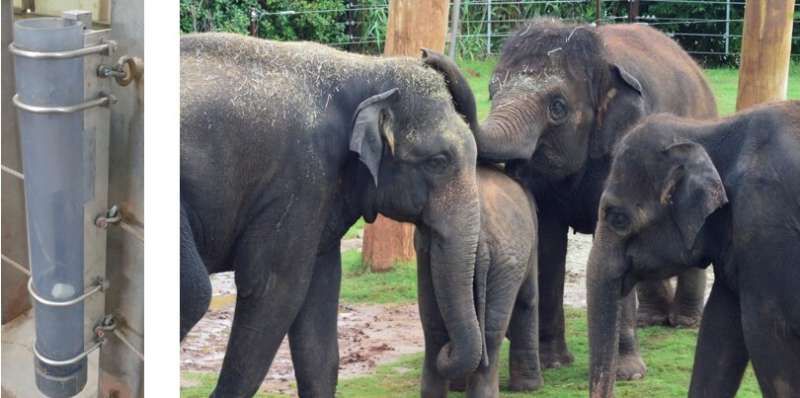Asian elephants are capable of using water as a tool

Elephants are known for their complex cognitive abilities, such as memory, problem-solving and tool use, and for their complex social behaviors. A new research article in the journal Animal Behavior and Cognition describes how Asian elephants perform on the floating object task, which is an established test of tool use and problem-solving.
The article was written by Lisa Barrett and Sarah Benson-Amram, in the University of Wyoming's Animal Behavior and Cognition Lab, led by Benson-Amram.
The floating object task was established as a standard assessment for comparing insightful tool use across species, yet it had only previously been presented to primates. In the floating object task, an animal is presented with a tube containing some water and a floating reward, such as a peanut or a marshmallow. To access the reward, the animal must add more water to the tube, which raises the water level and brings the reward within reach.
Primates, such as orangutans and chimpanzees, often spit water into the tube. Here, the authors were curious if elephants could use their trunks to solve the task.
The authors of the paper tested 12 Asian elephants—housed at the National Zoological Park in Washington, D.C., and the Oklahoma City Zoo—with the invaluable help of elephant caretakers.
"Elephants use water all of the time for drinking and bathing, so I was fascinated to see if they would solve the floating object task," says Barrett, the lead author who recently received her Ph.D. from UW's Program in Ecology and the Department of Zoology and Physiology.
One female elephant, Shanthi, solved the floating object task. On her very first trial, Shanthi used her trunk to add water to the tube, but she did not add enough water to reach the marshmallow. In her second trial, she added enough water to raise the marshmallow to the top of the tube.
Barrett notes that Shanthi had been anecdotally known to add water to enrichment items at the zoo, so Shanthi's previous experience likely played a role in her ability to solve the novel task. Shanthi also solved the problem faster in each trial, which provides evidence of her learning to solve the task.
"It was very exciting to find that elephants are capable of solving this task and that they are able to learn the solution to a new problem as they gain experience with that problem," Benson-Amram says. "However, given that only one elephant was successful, we are interested in better understanding why this task was so difficult for them and what that means for our understanding of the evolution of tool use in animals."
As no other elephants solved the task on their own, and because elephants likely learn from one another in the wild, the authors extended the traditional use of the task to test for social learning in the elephants. To do this, the authors had naïve elephants watch Shanthi solve the problem at the National Zoological Park. The observer elephants were then presented with the task on their own, to see if they had learned how to solve it.
Because no elephants were successful at solving the task at the Oklahoma City Zoo, one female, Chandra, was trained by keepers to add water to the tube. After a few training sessions, Chandra reliably solved the task on her own, and she then demonstrated the solution for naïve observer elephants.
No observer elephants at either zoo solved the task after watching three demonstrations. However, at the Oklahoma City Zoo, observer elephants spent more time interacting with the task compared to control elephants that did not receive a demonstration. This suggests that the observers were paying attention to the demonstrator and were interested in the apparatus, but this increased interest did not lead to an increase in problem-solving success.
In their paper, the authors offer some possible explanations for these results. For example, it is possible that age of the observers/demonstrators, relationship to the demonstrator and location-specific differences—such as enclosure size and feeding schedule—affected how closely the observers watched the demonstrators. For example, at the Oklahoma City Zoo, unlike at the National Zoological Park, two of the observers were related to the demonstrator, so they may have been more likely to pay attention. It is possible that three demonstrations were not sufficient for observers to learn the task from the demonstrator.
Alternatively, observers may not have been able to see the water level and/or reward, or the observers may have been relying on their senses of smell and sound instead of sight, and these cues may not have given the observers sufficient information to learn how to solve the task.
"We also are investigating how individual variation, such as personality, plays a role in determining which elephants solve the puzzles we give them," Barrett says.
Although more research is needed to determine elephants' level of understanding of the task, Barrett and Benson-Amram found that at least one Asian elephant is capable of using water as a tool to solve the problem.
"We encourage more work with other non-primate, non-avian species in order to better understand the evolution of cognition in animals," Benson-Amram says.
This type of cognitive research has implications for captive elephant welfare and management, as well as wild elephant conservation. Asian elephants are endangered, in part, because of conflict with humans when they raid farmland, and cognition could play a role in terms of which individuals raid and how successful they are in raiding.
More information: Lisa P. Barrett et al. Can Asian Elephants Use Water as a Tool in the Floating Object Task?, Animal Behavior and Cognition (2020). DOI: 10.26451/abc.07.03.04.2020
Provided by University of Wyoming



















